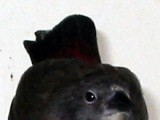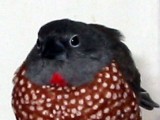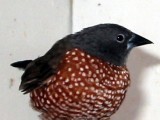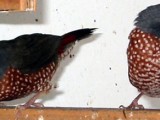Brown Twinspot
Brown Twinspot
(Clytospiza monteiri)
by Ian Hinze
Pytelia monteiri Hartlaub, 1860, Proc. Zool.
Soc. London. P111, pl. 161.
Monotypic: Clytospiza monteiri – generic name Greek: klutos, splendid, beauteous; spiza, a finch; specific name after John Monteiro (d.1878) collector in Angola, 1860-1875, and author.
DESCRIPTION
Length 13 cm (5 in). The sexes differ. The male has the entire head dark slate grey except for a bright vermilion or orange-red median stripe from the middle to the lower throat. The mantle, back and wings are a dull dark earth brown. The underwing coverts are barred chestnut and white. The rump and upper tail coverts are dark orange red. The tail is brownish black. The breast and underparts are rich chestnut brown, sometimes tinged with red on the ventral area and under tail coverts, and spotted and barred with white. Most feathers of the upper breast and flanks have two paired roundish white spots and occasionally
two smaller and fainter spots nearer the base of the feather. The spots intergrade into bars, usually two on each feather, on the belly, lower flanks and under tail coverts. The irides are blood red, dark red or reddish brown. The eye-rims are bluish. The bill is black, with the base greyish blue. The legs and feet are fleshy
brown.
The female has no red on the throat but has a dull white median stripe that runs right up to the base of her lower mandible. The orange-red of her rump, the chestnut of her underparts and the grey on the sides of her head are paler than in the male. Juveniles are a lighter and less greyish brown on the upperparts with the head a more brownish grey. The underparts are a duller and paler chestnut brown without white markings apart from indistinct whitish barring on the belly, ventral area and under tail coverts. The rump and upper tail coverts are dark rusty orange. Young males have the grey of the head and the chestnut of the breast darker than young females. Three-day-old nestlings have dark skin and quite profuse pale down. Their mouth markings consist of five black spots on the yellow palate, a black band, narrowing centrally, across the flesh-coloured tongue and a black crescent inside the lower mandible. The swollen bi-lobed gape flanges are white or white externally and yellow on the inside. There is a black spot on the inside of the gape, at the base of each mandible.
FIELD GUIDE
A small dark grey and dark brownish bird with a red rump and blackish tail and diagnostic chestnut-brown, white-spotted breast and underparts. The tail is noticeably fan-shaped when spread and the red rump and upper tail coverts are conspicuous as the bird flits into cover.
VOICE
The following is all taken from Goodwin (1982). The close contact call is a repeated vay, vay, vay… which is intensified and tends to be uttered in longer series as a distance contact call. Young that have recently fledged utter a loud eek, eek, eek that enables the parents to locate them when they hide in cover.
The alarm call is a hard-sounding Sylvia-like tek. The song of the male, which appears to be only courtship-oriented, is a variable series of notes, difficult to describe and unlike that of any other estrildid. It has been likened to the ‘crackling’ of Bishop weavers, Euplectes species.
DISTRIBUTION
Southeast Nigeria, Cameroon, southern Gabon, southern Republic of the Congo, Cabinda and northwest Angola; also the Central African Republic to central and northern Democratic Republic of the Congo, extreme southern Chad, southern Sudan (north to Bussere), west and southern Uganda and western Kenya (from Busia and Mumias Districts south to Siaya, Ng’iya and Akala).
STATUS
Uncommon or locally common.
HABITAT, GENERAL BEHAVIOUR AND FEEDING
It is found at 1000-1500 m inhabiting savanna with tall grass and shrubbery, forest glades and edges, moist brushland and overgrown cultivated areas (Goodwin 1982: van Perlo 1995; Zimmerman, et al., 1996). It is usually seen in pairs or small parties (most likely family groups) low down near ground cover
(Clement et al., 1993; Restall 1975; Zimmerman, et al., 1996). It feeds primarily (probably entirely) on the ground, where it moves with long quick hops, in a horizontal stance. It is known to take grass seeds, insects including termites, and spiders (Goodwin 1982).
COURTSHIP DISPLAY
Goodwin (1982) relates that the courtship display is like that of the Peters’ Twinspot Hypargos niveoguttatus except that the male’s movements are more jerky and less graceful. While carrying a blade of grass or feather in his bill and singing at the same time he performs long hops around or half around the female, usually with his tail spread and angled towards her and his head alternately pointed upwards at an angle of about 70º and bowed towards the female at an angle of about 30º. The display may occur without any nesting symbol or it may be held only at the beginning of the display. The female may perform the same
movements in synchrony with her mate or remain passive. If she solicits, in the usual manner with quivering tail, copulation follows.
NESTING
Chapin (in Goodwin 1982) found the species breeding in old nests of the Bronze Mannikin, Lonchura cucullata, and other (unidentified species). These old nests had been re-lined with hair, feathers, soft vegetable material and, without exception, also with some cast snake skin. Zimmerman et al., (1996) mention that it is said to also use old weaver nests for roosting and nesting in. Small domed nests have also been described which, presumably, were built by the Brown Twinspot itself. Breeding takes place at the end of the rains and the beginning of the dry season. In the Uelle district of the Democratic Republic of
Congo it breeds from August to December; in Uganda from June to October and in southern Sudan in September (Goodwin 1982).
CAPTIVE OBSERVATIONS
This is a very rare and probably non-existent species in UK aviculture (and the USA?) and I can find no breeding records for it. Restall (1975) says that specimens are reputed to be shy but that it has been bred several times in South Africa. Goodwin (1982) gives the only observations I can find and these are: it will take various millets, and some individuals will also take canary seed. Soaked spray millet and chickweed are also sometimes taken, sometimes soaked seed and greenfood are only taken at breeding time. Ant pupae, whiteworms and the half-ripe seeds of various unidentified grasses, and home-grown millet were eagerly taken when the adults were rearing young. Individual birds have been observed swallowing seeds without first dehusking them. It will build its own nest, which may be round or more or less elongated in shape depending on where it is sited, among twigs or bushy cover, on the remains of an old nest or on a rough platform of grass, etc., purposely placed for such. A nest-box has also been utilised. Various nesting materials may be used but when ample choice has been given the nest was always mainly built of broad blades of grass, preferably green, and wheat, and thickly lined with feathers. Throughout incubation and the brooding of nestlings the male takes feathers and pieces of green grass into the nest. The large side entrance of the nest is always screened or ‘closed’ by a feather while eggs and young are being brooded. The male alone collects material but if the female is in the nest she may take feathers from him and position them. Up to 5 feathers have been known to be carried at a time. A clutch of eggs number 4-6 and the incubation period is around 13 days. The young fledge at 19-21 days.
Being so rare and with so little known about it this species must only be kept by the most dedicated and accomplished aviculturists. Hailing from tropical Africa its acclimatization must be undertaken with care, with temperatures not being allowed to drop below 22º Celsius (70ºF.).
OTHER NAME Monteiro’s Twinspot.
This site uses Akismet to reduce spam. Learn how your comment data is processed.





Leave a Reply
You must be logged in to post a comment.